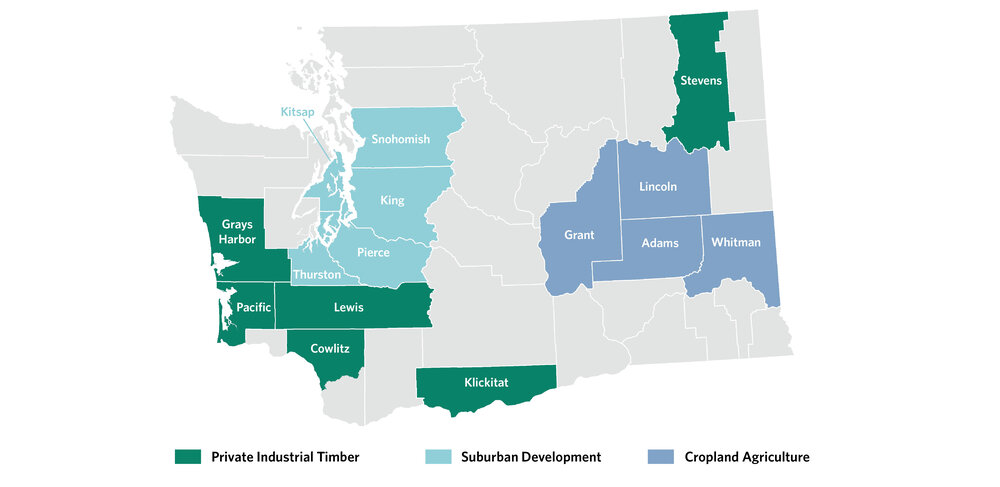The latest science coming from a partnership between The Nature Conservancy (TNC) and the University of Washington (UW) highlights ways nature can help Washington achieve its net-zero greenhouse gas emissions goal by midcentury.
The study—”Leveraging the potential of nature to meet net zero greenhouse gas emissions in Washington State”—centers on how Natural Climate Solutions (NCS) harness the capacity of forests, wetlands and farmlands to absorb and store carbon dioxide that’s in the atmosphere, lessening the impacts of climate change.
What are Natural Climate Solutions?
Worldwide, nature’s power to breathe, filter and store carbon can provide more than 1/3 of emissions reductions needed to meet the Paris Agreement target. Natural Climate Solutions harness the tremendous capacity of forests, wetlands and farmlands to combat climate change. Changing how we manage, protect and restore our natural resources to be more sustainable and have a climate benefit is essential to slow the pace of climate change and its impacts on people and nature.
According to the new study, which focuses on Washington, the state’s natural spaces have the potential to capture up to 8.8 million metric tons of CO2 annually by midcentury, accounting for over 9 percent of the state’s net-zero goal. How much of the goal is met depends on how quickly and effectively solutions are implemented in these next few years before 2030 and continued over the following two decades.
What’s unique about the study is that it offers county-level insights into which NCS options offer the greatest potential in those counties. These insights will allow local communities and leaders across the state to identify and prioritize the most effective ways to work toward the state’s net-zero emissions goal.
>
“Every effort matters when it comes to climate. Giving nature the chance to soak up and naturally store carbon is one, easily attainable way to make a difference.”
Three big ways to better enable nature to capture and store carbon dioxide emerged in the study as having the most potential in supporting the state’s net-zero goal:
-
Deferred timber harvest—logging is delayed so that trees can grow bigger and capture and store more carbon.
-
Cropland management—the use of cover crops, no-till practices, and nutrient management in agricultural practices.
-
Avoiding forest conversion—avoiding cutting down forests for urban, suburban and/or rural development.
Not only do natural climate solutions help address the climate crisis, they also often provide many other benefits to people, communities, economies, and nature itself. These “co-benefits” are particularly relevant for communities adapting to, and persisting through, climate change. For example, improved cropland management practices could reduce the use of nitrogen-based fertilizers, in turn reducing nitrates seeping into and contaminating groundwater (nitrate-contaminated water has been directly linked to high cancer rates, low fertility rates, increased water treatment costs and devaluation of property). Reduced use of those fertilizers would also benefit marine, freshwater and soil environments. And, if multiple NCS strategies are employed in combination with each other, the co-benefits are similarly amplified.
Major Natural Climate Solutions Drivers in Washington State Highlighted clusters show where the highest-potential counties of the three highest-potential NCS strategies provide approximately half of each of those strategies’ emissions reductions in 2050. These strategies include: deferred timber harvest in Stevens, Klickitat, Cowlitz, Lewis, Pacific, and Grays Harbor counties; cropland management in Grant, Lincoln, Adams, and Whitman counties; avoided forest conversion in Snohomish, Kitsap, King, Pierce, and Thurston counties.
Further, the NCS strategies that offer the greatest impact largely coincide with and complement major economic sectors of given geographic regions—for example, cropland management is a key strategy with great potential in Eastern Washington, where agriculture is a major economic driver. This knowledge may support efficient, cost-effective and equitable approaches to NCS strategies.
It is important to note that while this scientific study from TNC and UW highlights tangible and very achievable ways to contribute toward the state’s net-zero emissions goal, NCS strategies won’t address our state’s climate goals alone—they must also be complemented by rapid and widespread emissions reductions in transportation, energy and industry sectors. When it comes to addressing the climate crisis, though, every bit of effort matters.
The opportunity to harness the power of nature through natural climate solutions shouldn’t be passed up. Not only can NCS strategies account for over 9 percent of Washington’s net-zero emissions goal, but this study opens routes to better understanding the long list of NCS co-benefits and complementary economic opportunities that NCS may provide. This supports and informs actions that give plenty of reason for hope in addressing the climate crisis.
Learn More About Our Work on Climate Change
Header photo © Peter Dunwiddie / TNC
